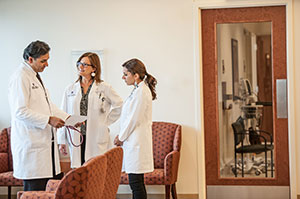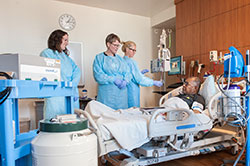Stem Cell Transplant Process
How the Process Works
 The Northwestern Medicine Hematopoietic Stem Cell Transplant Program has become a leading stem cell transplant program, providing care and services for recipients and donors from Illinois, around the United States, and other locations around the world.
The Northwestern Medicine Hematopoietic Stem Cell Transplant Program has become a leading stem cell transplant program, providing care and services for recipients and donors from Illinois, around the United States, and other locations around the world.
Stem cell transplantation, also called bone marrow transplantation, is typically used to treat cancers such as leukemia, lymphoma, multiple myeloma, and myelodysplastic syndromes. It also may be an option for those with aplastic anemia and myelofibrosis.
Once your doctor has referred you to the Stem Cell Transplant Program, a nurse coordinator will work with you to contact your insurance company and receive approval for the stem cell transplant. The actual stem cell transplant process begins with the collection of stem cells from either the patient or a healthy donor.
Most stem cells are found in the bone marrow, the spongy tissue inside the large bones, and can also be found in the bloodstream with the help of certain medications.
 The patient or donor donates stem cells via a machine called an apheresis machine. Stem cells are harvested from blood drawn through a catheter in the chest or neck.
The patient or donor donates stem cells via a machine called an apheresis machine. Stem cells are harvested from blood drawn through a catheter in the chest or neck.
The blood flows through the line to the machine, which separates the stem cells from the rest of the blood. The remaining blood is returned to the donor through another line.
After the stem cells are collected, they are processed in the Mathews Center for Cellular Therapy. A lab technician evaluates the cells to make sure they are not infected and counts them to make sure there are enough for a transplant. Each bag contains several million stem cells.
Once stem cells are processed, they are preserved through a special freezing procedure. A thin, metal case contains the flattened bag of stem cells that will be placed in the freezer. Cooled by liquid nitrogen, the freezer keeps stem cells at 180 degrees Centigrade below zero.
 The transplant happens through reinfusion, a relatively simple and painless process wherein stem cells are infused into the patient. The stem cells are thawed in a room temperature water bath and then hung on an IV pole so they can be connected directly to the patient’s IV, much like a blood transfusion.
The transplant happens through reinfusion, a relatively simple and painless process wherein stem cells are infused into the patient. The stem cells are thawed in a room temperature water bath and then hung on an IV pole so they can be connected directly to the patient’s IV, much like a blood transfusion.
After reinfusion, the patient enters the engraftment stage where stem cells migrate to the bone marrow and start producing new blood cells. Generally, engraftment takes one to three weeks before white blood cells are produced and 10 days to 4 weeks for red blood cells and platelets. Patients generally remain in the hospital for two to three weeks following their stem cell transplant to recover from any side effects.
Once discharged, stem cell transplant recipients are vulnerable to side effects and infection and will be seen in the HSCT clinic with their attending doctor and a stem cell transplant advanced practice nurse.
How to be a donor
You can help save a life. The stem cell donation process is safe and simple and the National Marrow Donor Program is always looking to add healthy donors to their registry.
